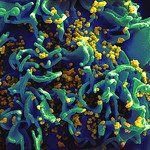This week in PLOS Biology
In PLOS Biology this week, you can read about plant extinction at the end of the Cretaceous, human tolerance to HIV and control of plant responses to hypoxia.
The End-Cretaceous Impact Winter Killed Off Slow-Growing Plants

Sixty-six million years ago the Chicxulub bolide impacted the Earth, marking the Cretaceous–Paleogene boundary. We all know about the association between this event and the extinction of the non-avian dinosaurs, but what about the plants? In a new research paper, Benjamin Blonder, Brian Enquist and colleagues have addressed the survival strategies of the plants (half of which went extinct at this time). Using >1000 fossil leaves, spanning a 2-million-year interval, they used leaf minor vein density and leaf mass per area as proxies for carbon assimilation and carbon investment. Their results supported the hypothesis that an impact winter would have selected against slow-growing evergreen species, a possible cause of the modern dominance of high-productivity deciduous angiosperm forests. Read more in the accompanying synopsis.
Human tolerance against HIV
Roland Regoes and colleagues, in their new research article, have addressed the strategies of ‘tolerance’ and ‘resistance’ in humans, in the context of HIV. They asked used the Swiss HIV Cohort Study to ask if humans vary in their tolerance to HIV, and whether there is a genetic basis for tolerance. CD4+ T-cell increase was used as a proxy for tolerance, and viral load decline for resistance in a well-studied cohort of infected individuals. They found that tolerance and resistance had independent genetic origins and also that individuals who are heterozygous for the HLA-b immunity gene are more tolerant. Younger people were more tolerant to HIV infection. These findings add to our understanding of how hosts tolerate infections and could open new avenues for treating infections.
DNA Binding Protein Controls Plant Transcription when Oxygen is at a Premium
Plants need to be able to maintain respiration during hypoxic events, such as waterlogging of their roots during flooding. The main regulator of the response to these events has been identified as RAP2.12, which is produced under normal conditions, but then degraded. In hypoxic conditions this degradation stops. Now Beatrice Giuntoli, Pierdomenico Perata and colleagues have addressed the flipside of this: what prevents an inappropriately excessive hypoxic response? They found that the transcription factor HRA1 is needed, and creates a negative feedback loop with RAP2.12. The authors argue that this could have implications for breeding flood-resistant crops.

